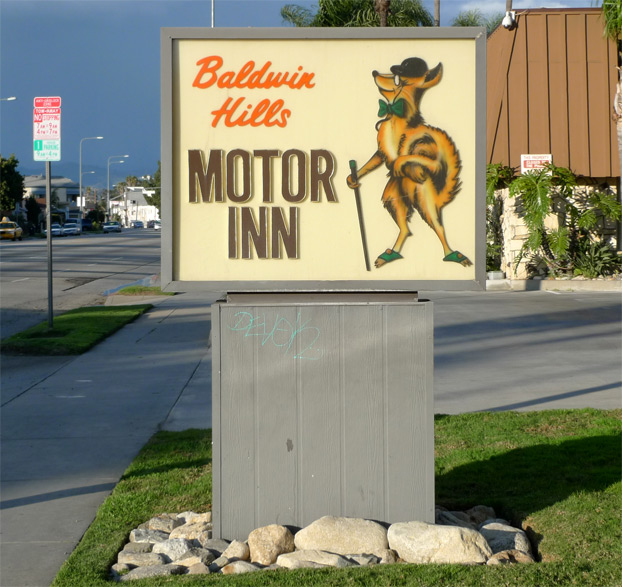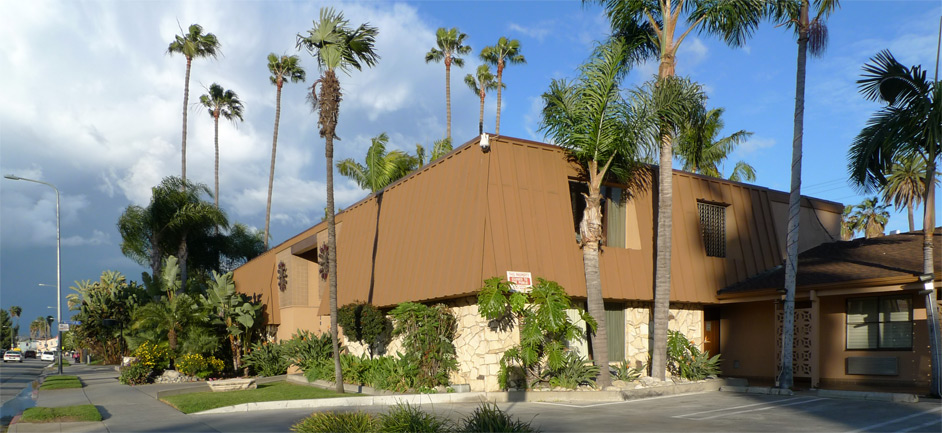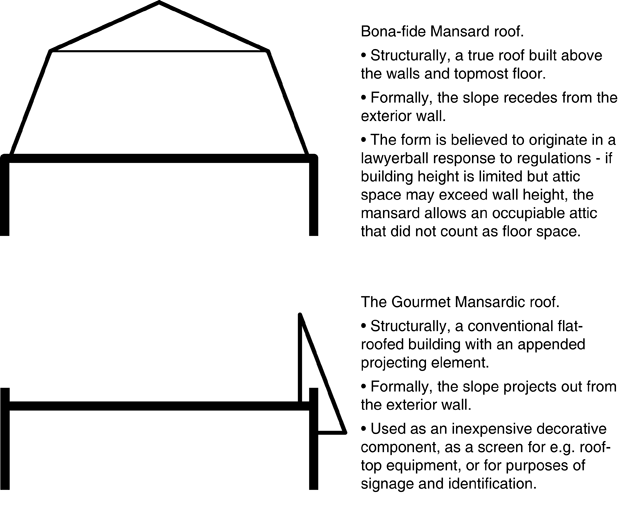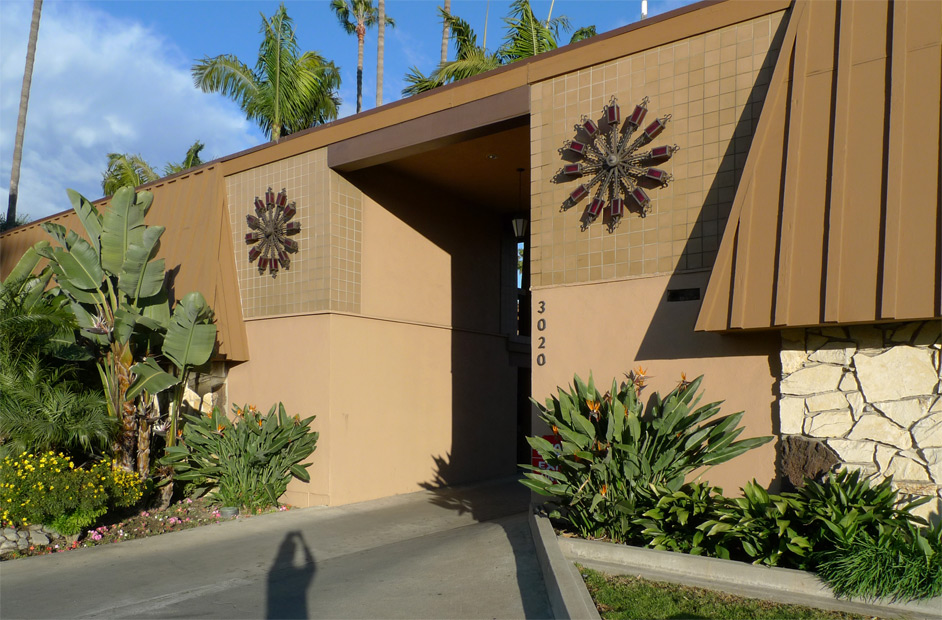Today’s featured project is the Baldwin Hills Motor Inn, a fine and well preserved specimen of a Lomo style that we shall call The Gourmet Mansardic, located at 3020 South La Brea Avenue near Jefferson Boulevard in Los Angeles. According to the assessor’s records, The B.H.M.I. was built in 1948 with a major addition in 1972, and that swingin’ seventies style dominates – this place is frozen time.

The newer part of this motel belongs to an architectural subgenre of Los Angeles motels that share its basic orientation, largely presenting a windowless, decorated wall to the street, and accessed via deck from the rear.
If the architecture were not enough to signal that this place is all about smooth sophistication, the lightbox sign features an upright fox wearing a cap, bowtie, monacle, slippers and a walking stick:

There is another contemporary motel on Western called the Snooty Fox Motor Inn, which features the identical mascot on its sign. Snooty foxes are evidently a venerable meme that conveys notions of upper-class hedonism or licentiousness, although the search engines did not deign to reveal to me the etymological origins of snooty foxes, literary or otherwise.

The somewhat sprawling and segmented Baldwin Hills Motor Inn is unified by the repeated device of an overscaled, red mansard roof. The B.H.M.I.’s mansard is a good and particularly prominent example of the roof form that defines the architectural style that Reyner Banham termed the “Gourmet Mansardic” in his Los Angeles: The Architecture of Four Ecologies. Banham denigrated these mansards as “the small, steeply pitched false roof-fronts that justify the stylistic epithet Gourmet Mansardic” (p. 122).
Banham’s unveiled, dismissive tone is meant to convey that such design is contemptible, beneath architecture proper; but like Venturi and Scott Brown getting euphoric about Las Vegas, Banham also revels in his transgression. He gets a thrill from breaking curfew, sneaking out, hanging out on the wrong side of the tracks where the Tacoburger Aztec mingles with the Polynesian Gabled. Much of the verve of this influential book derives from Banham’s own sense of taking a walk on the wild side.
In his essay about mid-century revivalist styles centered on architecture for the Hollywood “industry” community, “How Can I Miss You When You Won’t Go Away?” (published in the volume Glitter Stucco & Dumpster Diving), John Chase described the mansard more soberly, acknowledging their sullied reputation: “but by the end of the 1960s, the pop-up mansard could just as easily have been a symbol for cheesy and cheap” (p. 93). At the Baldwin Hills Motor Inn, the pop-up mansard conveys an earnest striving.

The “Gourmet Mansardic” style is broad enough and interesting enough (not to mention seriously underappreciated and widely disparaged) that it could easily be by itself the focus of a website, research project, or scholarly study. It stands among the most important and substantial of the Lomo styles, one to which my Lower Modernisms project must surely return again and again.
With its allusions to colonial-era French cosmopolitanism, the Mansardic style was employed by its designers to express a kind of sophistication, the same brand of now-dated worldliness packaged as a lifestyle by vintage Playboy magazines and seen in older ads for products like gin and “cool” menthol cigarettes. The mansard, in its tawdry fashion and with limited success, sought to convey the same kind of sexy cool that Mad Men renders beautiful. The Mansardic style was a frequent choice for apartments and small retail centers, but most characteristically Mansardic were a trio of small freestanding building types: liquor stores, dry cleaners, and dentist’s offices. Those three ostensibly unrelated programmes have in common not only intoxicating odors, but a desire to convey modernity without seeming alienating or sacrificing the comforts of tradition.
The adjectival form of “Mansardic” implies that these are not true mansards, but rather a building element that is merely mansard-like. As opposed to the righteous mansard, which is a type of roof, the mansard of the Gourmet Mansardic is an applied bit of architectural decoration that happens to share the sloping shape of the true mansard. It projects outward from the building, forming a handy overhang, rather than receding from the exterior walls like a true mansard. But both types of mansard similarly soften the hard edge at the top of a conventional flat-roofed building.

The mansard not only softens the building in its physical form, but also figuratively softens a hard-edged Modern building with a casual kind of historicization. At the time, the Mansardic device must have been perceived as a Modern and contemporary way of using an historical architectural language, which invites comparison with the way that later Postmodern architects would use historical reference.

As detailed in the photograph above, the B.H.M.I.’s mansard is finished with 2×4 battens over plywood boards. The bottoms of the boards are flush with a cement-plaster soffit, and a thick, crude, painted sealant bead negotiates the joint. Architects today can seldom be so casual about the watertightness of their building envelope, although there is no reason to assume that this detail is incapable of adequate performance.
The rhythm of the heavy 2×4 battens give a strong vertical emphasis to the mansard, as was typical. Although the board-and-batten approach used here is Honest (in the Lou-Kahn disciplinary sense) in that it actually is what it appears to be, a construction of battens concealing the seams in the plywood boards and offering a measure of weather protection, the roof still seems to be imitating or alluding to a metal standing-seam roof, which was a common assembly on true mansard roofs in the 19th century.

The northern wing of the motel is accessed by driving beneath the mansard to a small protected parking lot, where balcony-access corridors lead to upper roofs. Surprisingly, this portion of the motel appears to be of post-and-beam construction of heavy timbers. With the actual structure of the building on display, painted and exposed, the B.H.M.I. demonstrates an unexpected Modernist honesty-of-materials rigor.
“Heavy timber” is not solely a description here, but a technical term from the building code that defines a particular Construction Type. Most typically consisting of timber beams and columns at least 6” in nominal thickness with floors and roofs of decking at least 2” thickness, “H.T.” buildings are assumed to have a relatively high level of intrinsic fire resistance due to the fact that these larger wood members are quite slow to ignite. This was a relatively expensive and high-quality method of construction for a motel of this size, where we would expect to see ordinary stud and joist framing.

On the corner, the motel designer has thoughtfully accommodated users of the bus stop by incorporating a cantilevered concrete slab bench into the scope of construction. The waiting bus rider is lightly embraced by a curved, canted Flintstones rock wall and the thriving dinosaur landscape. The lamppost is unusually scaled, with a giant (and awesome) circular head on a short, human-scaled post.

Vehicular access to the northern wing passes through a gatehouse-like aperture between the mansards, a passage from exterior to interior without leaving your car. Four materials come together, the mansard paired with the rock wall giving way to plaster and tile at this transitional threshold zone. The wall-mounted light fixtures are arranged like two googly eyes around the opening. The Medievalizing style of these lamps complements the architecture of mansard and rock. We might expect to see just one lamp, but here 12 lamps are arrayed in the fashion of a clock face, evocative of George Nelson’s iconic clock designs and creating a sense of playful exaggeration.

At night, these gatehouse lamps shine warmly.
Leave a Reply